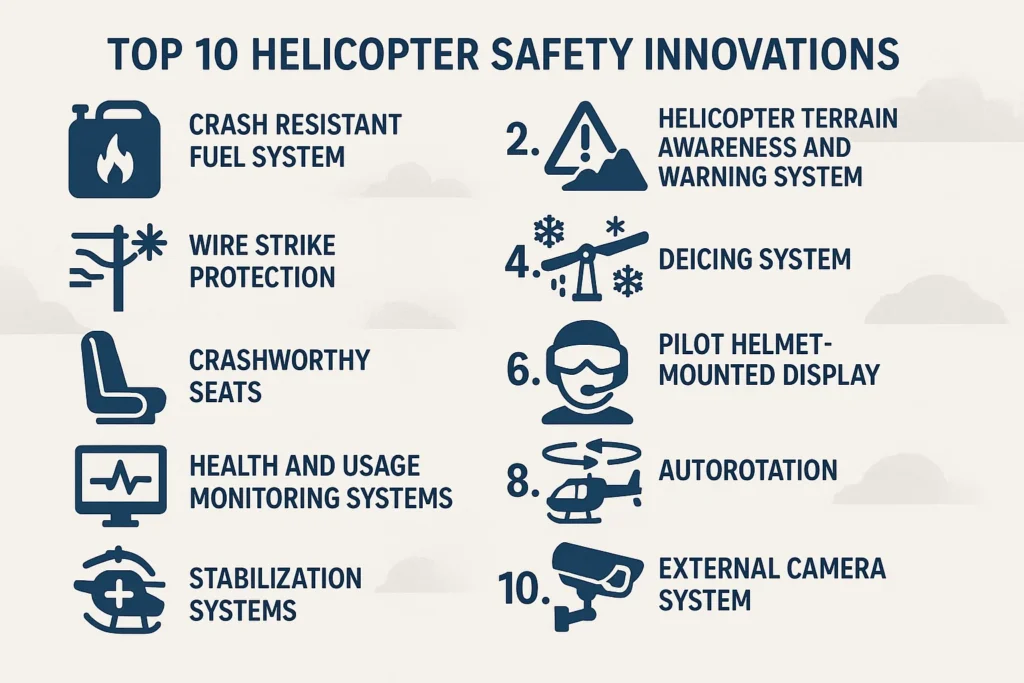✨ Introduction: Top 10 Helicopter Safety Innovations
Helicopters are known for their versatility in performing tasks like search and rescue, tourism, and emergency medical transport, but ensuring their safety is paramount. Over the years, innovative technologies and design improvements have made helicopters safer for both passengers and pilots.
In this blog post, we explore the top 10 helicopter safety innovations that have enhanced aerial safety and helped revolutionize the way helicopters are operated. These innovations not only improve safety but also give passengers and crew greater peace of mind during every flight.
🌍 1. Enhanced Rotorcraft Control Systems (Fly-By-Wire)
🛠️ Overview:
Fly-by-wire technology has significantly improved the control of modern helicopters. This system replaces traditional mechanical controls with electronic interfaces, providing more precise control and improving pilot response to emergency situations.
✨ Highlights:
-
Increased stability and control during flight.
-
Real-time monitoring of flight data to enhance pilot awareness.
-
Quick response time to prevent accidents.
-
Benefit: Fly-by-wire systems make helicopters easier to handle in challenging conditions, reducing human error and improving flight stability.
🚁 2. Advanced Autopilot Systems
🛠️ Overview:
Modern helicopters now feature advanced autopilot systems that can assist pilots in maintaining stable flight, especially in adverse weather conditions. These systems can take over tasks such as navigation, altitude control, and heading adjustments, helping pilots manage complex flights.
✨ Highlights:
-
Automatic altitude control and flight path adjustments.
-
Enhanced stability in turbulent air.
-
Provides pilots with a backup during critical flight phases.
-
Benefit: Autopilot systems reduce pilot workload, making the helicopter safer, especially in high-stress environments.
🏞️ 3. Helicopter Terrain Awareness and Warning Systems (HTAWS)
🚨 Overview:
HTAWS is an essential safety innovation that warns pilots of possible collisions with terrain or other obstacles, especially in low-visibility conditions. The system provides audible warnings and visual alerts, helping pilots avoid dangerous situations.
✨ Highlights:
-
Real-time terrain mapping to identify potential hazards.
-
Audible alerts for pilots to adjust flight paths.
-
Increased situational awareness for both pilots and passengers.
-
Benefit: HTAWS improves safety when flying over mountainous terrain or in poor visibility, reducing the risk of accidents.
🏢 4. Emergency Floatation Systems (EFS)
🏖️ Overview:
Emergency Floatation Systems (EFS) are critical for helicopters operating over water. These systems automatically deploy inflatable floats in case of a water ditching, allowing the helicopter to stay afloat until rescue operations can begin.
✨ Highlights:
-
Automatic floatation deployment during emergency landings in water.
-
Enhanced flotation for longer periods.
-
Quick rescue response with increased visibility for rescue teams.
-
Benefit: EFS increases the chances of survival when emergency landing over water, making sea-based helicopter operations safer.
🚁 5. Crash-Resistant Fuel Systems
🛢️ Overview:
Helicopters now feature crash-resistant fuel systems designed to prevent fires after accidents. These systems use specialized fuel tanks that are bladder-type and self-sealing, reducing the likelihood of a fire in the event of a crash.
✨ Highlights:
-
Self-sealing fuel tanks prevent fuel leaks during crashes.
-
Fire suppression systems that activate automatically.
-
Durable construction to withstand impacts.
-
Benefit: These systems prevent fuel leaks and fire hazards, significantly improving passenger safety during accidents.
🌍 6. Integrated Data Monitoring Systems (Flight Data Recorders)
📝 Overview:
Flight Data Recorders (FDR) are an essential part of modern helicopters, capturing critical flight parameters such as altitude, speed, and engine performance. This data is invaluable for post-incident investigations and helps improve flight safety.
✨ Highlights:
-
Real-time data recording of all critical flight parameters.
-
Automatic transmission of data in case of an emergency.
-
A vital tool for safety audits and incident investigations.
-
Benefit: FDRs help identify the causes of incidents and improve flight safety protocols for future operations.
🏞️ 7. Night Vision Goggles (NVGs) for Pilots
🌙 Overview:
Night Vision Goggles (NVGs) are used by pilots flying at night or in low-visibility conditions. NVGs help pilots see better in the dark, improving their ability to navigate through dimly lit areas or turbulent weather.
✨ Highlights:
-
Improved visibility in low-light conditions.
-
Safer night-time operations and emergency landings.
-
Increased situational awareness for pilots during night flights.
-
Benefit: NVGs enhance the safety of helicopters flying at night or in poor visibility, making night operations safer.
🏙️ 8. Fire-Resistant Cabin Materials
🔥 Overview:
Helicopter manufacturers are now using fire-resistant materials for the interiors of helicopters. These materials are designed to withstand extreme heat, reducing the risk of fire spreading inside the cabin in case of an accident.
✨ Highlights:
-
Fire-resistant seats, cabin panels, and insulation.
-
Quick containment of fires inside the cabin.
-
Safer cabin environment during emergency landings.
-
Benefit: Fire-resistant materials significantly reduce the chances of fire injuries during accidents, improving overall passenger safety.
🛬 9. Advanced Pilot Training and Simulation Systems
🏫 Overview:
Advanced flight simulators have transformed pilot training. These systems provide highly realistic training for emergency scenarios, weather conditions, and complex flight maneuvers, ensuring that pilots are well-prepared for anything that may occur during a flight.
✨ Highlights:
-
Realistic simulation of emergency scenarios like engine failure or uncontrolled descent.
-
Comprehensive training for all types of weather conditions.
-
Continuous pilot performance monitoring and feedback.
-
Benefit: Highly trained pilots reduce the risk of human error and increase flight safety.
🌍 10. Active Noise Reduction (ANR) Technology
🏞️ Overview:
Active Noise Reduction (ANR) technology is a significant safety feature that reduces the sound levels inside the helicopter cabin. This technology helps both passengers and pilots hear critical communications clearly, especially during high-speed flights.
✨ Highlights:
-
Noise-cancelling headsets for clearer communication.
-
Reduced cabin noise for better concentration.
-
Enhanced comfort during long flights.
-
Benefit: ANR technology improves communication between pilot and crew, reducing distractions and improving safety.
🌍 Conclusion: Top 10 Helicopter Safety Innovations
Helicopter safety has come a long way with the advent of these innovative technologies and design improvements. From advanced autopilots and collision avoidance systems to fire-resistant cabins and crash-resistant fuel tanks, these innovations have significantly reduced risks and made helicopter travel safer for everyone.
At DreamSafar, we are committed to offering you the safest and most comfortable helicopter experience. Whether you’re flying for leisure, business, or emergency purposes, our cutting-edge fleet is equipped with the latest safety innovations to ensure a smooth and secure flight.
🔗 Useful Links:
Resources:
❓ FAQ Section:
Q1: How do modern helicopter safety systems work?
A1: Modern safety systems, like fly-by-wire, terrain awareness systems, and crash-resistant fuel tanks, work together to enhance flight control, prevent collisions, and minimize fire risks in case of an emergency.
Q2: Are night flights safer with new safety technologies?
A2: Yes, with innovations like night vision goggles (NVGs) and advanced autopilot systems, night-time operations have become safer and more efficient, improving visibility and control.
Q3: How do pilot training simulators contribute to safety?
A3: Flight simulators provide pilots with realistic training for various emergency scenarios, ensuring that they can respond effectively during high-risk situations, thereby reducing the likelihood of accidents.


